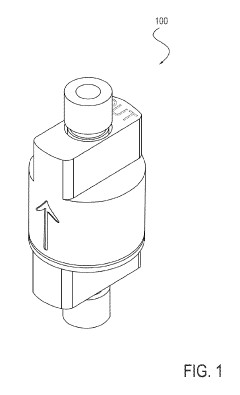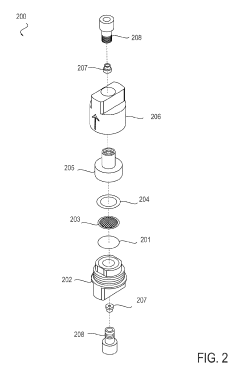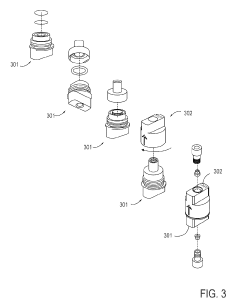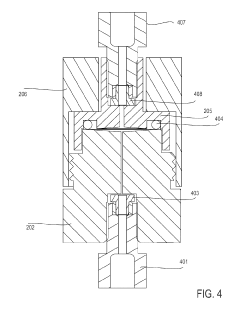Isopentane in Hydraulic System Maintenance Solutions
JUL 25, 20259 MIN READ
Generate Your Research Report Instantly with AI Agent
Patsnap Eureka helps you evaluate technical feasibility & market potential.
Isopentane in Hydraulics: Background and Objectives
Isopentane, a branched-chain alkane with the molecular formula C5H12, has emerged as a subject of significant interest in hydraulic system maintenance solutions. The evolution of hydraulic systems has been marked by continuous efforts to enhance efficiency, reliability, and environmental sustainability. In this context, isopentane presents a promising avenue for innovation due to its unique physical and chemical properties.
The historical development of hydraulic fluids has seen a progression from simple mineral oils to more sophisticated synthetic and bio-based formulations. Each iteration has aimed to address specific challenges such as thermal stability, viscosity control, and compatibility with system components. Isopentane, with its low boiling point and excellent heat transfer characteristics, represents a potential paradigm shift in how we approach hydraulic system maintenance and operation.
The primary objective of researching isopentane in hydraulic systems is to explore its potential as a novel working fluid or additive that could revolutionize system performance and maintenance practices. This research is driven by the increasing demands for more efficient and environmentally friendly hydraulic solutions across various industries, including manufacturing, construction, and aerospace.
One of the key areas of focus is the potential of isopentane to improve the thermal management of hydraulic systems. Traditional hydraulic fluids often struggle with heat dissipation, leading to reduced efficiency and increased wear on components. Isopentane's low boiling point and high vapor pressure at room temperature suggest it could offer superior cooling properties, potentially extending the life of hydraulic components and reducing maintenance frequency.
Furthermore, the research aims to investigate isopentane's role in enhancing the overall energy efficiency of hydraulic systems. By potentially reducing fluid viscosity and improving flow characteristics, isopentane could contribute to lower power consumption and improved system responsiveness. This aligns with the global push towards more energy-efficient industrial processes and machinery.
Another critical aspect of the research is to evaluate the environmental impact of incorporating isopentane into hydraulic systems. As industries face increasing pressure to reduce their carbon footprint and adopt more sustainable practices, the potential of isopentane as a more environmentally friendly alternative to traditional hydraulic fluids is of particular interest. This includes assessing its biodegradability, toxicity, and overall lifecycle impact.
The technological trajectory in this field is expected to lead to the development of novel hydraulic fluid formulations that incorporate isopentane, either as a primary component or as an additive. These formulations could potentially offer a balance of improved performance, reduced maintenance requirements, and enhanced environmental compatibility. As research progresses, it is anticipated that new applications and use cases for isopentane in hydraulic systems will be identified, potentially opening up new markets and industrial applications.
The historical development of hydraulic fluids has seen a progression from simple mineral oils to more sophisticated synthetic and bio-based formulations. Each iteration has aimed to address specific challenges such as thermal stability, viscosity control, and compatibility with system components. Isopentane, with its low boiling point and excellent heat transfer characteristics, represents a potential paradigm shift in how we approach hydraulic system maintenance and operation.
The primary objective of researching isopentane in hydraulic systems is to explore its potential as a novel working fluid or additive that could revolutionize system performance and maintenance practices. This research is driven by the increasing demands for more efficient and environmentally friendly hydraulic solutions across various industries, including manufacturing, construction, and aerospace.
One of the key areas of focus is the potential of isopentane to improve the thermal management of hydraulic systems. Traditional hydraulic fluids often struggle with heat dissipation, leading to reduced efficiency and increased wear on components. Isopentane's low boiling point and high vapor pressure at room temperature suggest it could offer superior cooling properties, potentially extending the life of hydraulic components and reducing maintenance frequency.
Furthermore, the research aims to investigate isopentane's role in enhancing the overall energy efficiency of hydraulic systems. By potentially reducing fluid viscosity and improving flow characteristics, isopentane could contribute to lower power consumption and improved system responsiveness. This aligns with the global push towards more energy-efficient industrial processes and machinery.
Another critical aspect of the research is to evaluate the environmental impact of incorporating isopentane into hydraulic systems. As industries face increasing pressure to reduce their carbon footprint and adopt more sustainable practices, the potential of isopentane as a more environmentally friendly alternative to traditional hydraulic fluids is of particular interest. This includes assessing its biodegradability, toxicity, and overall lifecycle impact.
The technological trajectory in this field is expected to lead to the development of novel hydraulic fluid formulations that incorporate isopentane, either as a primary component or as an additive. These formulations could potentially offer a balance of improved performance, reduced maintenance requirements, and enhanced environmental compatibility. As research progresses, it is anticipated that new applications and use cases for isopentane in hydraulic systems will be identified, potentially opening up new markets and industrial applications.
Market Analysis for Isopentane-based Hydraulic Solutions
The market for isopentane-based hydraulic solutions is experiencing significant growth, driven by the increasing demand for efficient and environmentally friendly maintenance solutions in various industries. The global hydraulic fluid market, which includes isopentane-based solutions, is projected to reach a substantial value in the coming years, with a steady compound annual growth rate.
The automotive sector represents a major market for isopentane-based hydraulic solutions, as manufacturers seek to improve vehicle performance and reduce environmental impact. The growing emphasis on electric and hybrid vehicles has further boosted the demand for advanced hydraulic systems that can operate efficiently under diverse conditions.
Industrial machinery and equipment form another crucial segment for isopentane-based hydraulic solutions. As industries strive for higher productivity and reduced downtime, the need for reliable and long-lasting hydraulic systems has intensified. Isopentane-based solutions offer improved thermal stability and oxidation resistance, making them attractive for heavy-duty applications in manufacturing, construction, and mining sectors.
The aerospace industry is emerging as a promising market for isopentane-based hydraulic solutions. With the increasing focus on fuel efficiency and weight reduction in aircraft, there is a growing interest in advanced hydraulic fluids that can withstand extreme temperatures and pressures while maintaining optimal performance.
Geographically, North America and Europe are currently the leading markets for isopentane-based hydraulic solutions, owing to their well-established industrial bases and stringent environmental regulations. However, the Asia-Pacific region is expected to witness the fastest growth in the coming years, driven by rapid industrialization, infrastructure development, and increasing adoption of advanced technologies in countries like China and India.
The market is also influenced by the growing trend towards predictive maintenance and condition monitoring in hydraulic systems. Isopentane-based solutions, with their superior properties, align well with these trends, offering improved system reliability and extended maintenance intervals.
Environmental concerns and regulatory pressures are playing a significant role in shaping the market landscape. As governments worldwide implement stricter emissions standards and sustainability goals, there is a growing shift towards eco-friendly hydraulic fluids. Isopentane-based solutions, with their potential for reduced environmental impact, are well-positioned to capitalize on this trend.
In conclusion, the market for isopentane-based hydraulic solutions shows promising growth potential across various industries and regions. The combination of performance benefits, environmental considerations, and evolving industry needs is expected to drive continued innovation and adoption in this sector.
The automotive sector represents a major market for isopentane-based hydraulic solutions, as manufacturers seek to improve vehicle performance and reduce environmental impact. The growing emphasis on electric and hybrid vehicles has further boosted the demand for advanced hydraulic systems that can operate efficiently under diverse conditions.
Industrial machinery and equipment form another crucial segment for isopentane-based hydraulic solutions. As industries strive for higher productivity and reduced downtime, the need for reliable and long-lasting hydraulic systems has intensified. Isopentane-based solutions offer improved thermal stability and oxidation resistance, making them attractive for heavy-duty applications in manufacturing, construction, and mining sectors.
The aerospace industry is emerging as a promising market for isopentane-based hydraulic solutions. With the increasing focus on fuel efficiency and weight reduction in aircraft, there is a growing interest in advanced hydraulic fluids that can withstand extreme temperatures and pressures while maintaining optimal performance.
Geographically, North America and Europe are currently the leading markets for isopentane-based hydraulic solutions, owing to their well-established industrial bases and stringent environmental regulations. However, the Asia-Pacific region is expected to witness the fastest growth in the coming years, driven by rapid industrialization, infrastructure development, and increasing adoption of advanced technologies in countries like China and India.
The market is also influenced by the growing trend towards predictive maintenance and condition monitoring in hydraulic systems. Isopentane-based solutions, with their superior properties, align well with these trends, offering improved system reliability and extended maintenance intervals.
Environmental concerns and regulatory pressures are playing a significant role in shaping the market landscape. As governments worldwide implement stricter emissions standards and sustainability goals, there is a growing shift towards eco-friendly hydraulic fluids. Isopentane-based solutions, with their potential for reduced environmental impact, are well-positioned to capitalize on this trend.
In conclusion, the market for isopentane-based hydraulic solutions shows promising growth potential across various industries and regions. The combination of performance benefits, environmental considerations, and evolving industry needs is expected to drive continued innovation and adoption in this sector.
Current Challenges in Hydraulic System Maintenance
Hydraulic systems are critical components in various industries, including manufacturing, construction, and aerospace. However, these systems face several challenges in maintenance that can impact their performance, reliability, and longevity. One of the primary issues is contamination, which can occur through various sources such as wear particles, environmental debris, and moisture. These contaminants can lead to accelerated wear, reduced efficiency, and potential system failures if not addressed promptly.
Another significant challenge is the degradation of hydraulic fluids over time. Hydraulic oils can break down due to oxidation, thermal stress, and mechanical shearing, leading to changes in viscosity and lubrication properties. This degradation can result in reduced system efficiency, increased wear on components, and potential system malfunctions. Regular fluid analysis and timely replacement are essential but often overlooked maintenance tasks.
Seal and gasket deterioration pose another maintenance challenge. These components are crucial for maintaining system integrity and preventing leaks. However, they are subject to wear, aging, and chemical degradation, which can lead to fluid leaks, pressure loss, and system inefficiencies. Identifying and replacing worn seals before they fail is a critical but often difficult maintenance task.
Temperature management is also a significant concern in hydraulic system maintenance. Excessive heat can accelerate fluid degradation, reduce viscosity, and cause thermal expansion of components, potentially leading to system failures. Conversely, cold temperatures can increase fluid viscosity, leading to sluggish operation and increased energy consumption. Maintaining optimal operating temperatures through proper cooling systems and insulation is crucial but can be challenging in varying environmental conditions.
Cavitation is another issue that can severely damage hydraulic components. It occurs when the local pressure in a fluid drops below its vapor pressure, leading to the formation and collapse of vapor bubbles. This phenomenon can cause erosion of pump impellers, valves, and other components, reducing system efficiency and potentially leading to catastrophic failures. Identifying and mitigating cavitation requires careful system design and monitoring.
Lastly, the complexity of modern hydraulic systems presents challenges in diagnostics and troubleshooting. With the integration of electronic controls and sensors, identifying the root cause of system issues has become more complex. Maintenance personnel need to be skilled in both hydraulic and electronic systems, and have access to specialized diagnostic tools. This requirement for multidisciplinary expertise can make effective maintenance more challenging and time-consuming.
Another significant challenge is the degradation of hydraulic fluids over time. Hydraulic oils can break down due to oxidation, thermal stress, and mechanical shearing, leading to changes in viscosity and lubrication properties. This degradation can result in reduced system efficiency, increased wear on components, and potential system malfunctions. Regular fluid analysis and timely replacement are essential but often overlooked maintenance tasks.
Seal and gasket deterioration pose another maintenance challenge. These components are crucial for maintaining system integrity and preventing leaks. However, they are subject to wear, aging, and chemical degradation, which can lead to fluid leaks, pressure loss, and system inefficiencies. Identifying and replacing worn seals before they fail is a critical but often difficult maintenance task.
Temperature management is also a significant concern in hydraulic system maintenance. Excessive heat can accelerate fluid degradation, reduce viscosity, and cause thermal expansion of components, potentially leading to system failures. Conversely, cold temperatures can increase fluid viscosity, leading to sluggish operation and increased energy consumption. Maintaining optimal operating temperatures through proper cooling systems and insulation is crucial but can be challenging in varying environmental conditions.
Cavitation is another issue that can severely damage hydraulic components. It occurs when the local pressure in a fluid drops below its vapor pressure, leading to the formation and collapse of vapor bubbles. This phenomenon can cause erosion of pump impellers, valves, and other components, reducing system efficiency and potentially leading to catastrophic failures. Identifying and mitigating cavitation requires careful system design and monitoring.
Lastly, the complexity of modern hydraulic systems presents challenges in diagnostics and troubleshooting. With the integration of electronic controls and sensors, identifying the root cause of system issues has become more complex. Maintenance personnel need to be skilled in both hydraulic and electronic systems, and have access to specialized diagnostic tools. This requirement for multidisciplinary expertise can make effective maintenance more challenging and time-consuming.
Existing Isopentane-based Maintenance Solutions
01 Production and purification of isopentane
Various methods are employed for the production and purification of isopentane, including isomerization of normal pentane, separation from petroleum fractions, and distillation processes. These techniques aim to obtain high-purity isopentane for industrial applications.- Production and purification of isopentane: Various methods for producing and purifying isopentane are described, including separation from hydrocarbon mixtures, isomerization processes, and distillation techniques. These processes aim to obtain high-purity isopentane for industrial applications.
- Use of isopentane in polymer production: Isopentane is utilized as a blowing agent or solvent in the production of polymers, particularly in the manufacture of expandable polystyrene beads and other foam materials. Its low boiling point and inert nature make it suitable for these applications.
- Isopentane in refrigeration and heat transfer systems: Isopentane is employed as a refrigerant or heat transfer fluid in various cooling systems and heat pumps. Its thermodynamic properties make it an effective alternative to traditional refrigerants in certain applications.
- Isopentane in fuel compositions: Isopentane is used as a component in fuel compositions, particularly for improving the octane rating of gasoline and enhancing the performance of internal combustion engines. It may also be used in the production of synthetic fuels.
- Isopentane in chemical synthesis and industrial processes: Isopentane serves as a raw material or intermediate in various chemical synthesis processes and industrial applications. It is used in the production of other chemicals, as a solvent in extraction processes, and in the manufacture of specialty products.
02 Use of isopentane in polymer production
Isopentane is utilized as a blowing agent or solvent in the production of polymers, particularly in the manufacture of expanded polystyrene (EPS) and other foam materials. It contributes to the formation of cellular structures in these materials.Expand Specific Solutions03 Isopentane in refrigeration and heat transfer applications
Isopentane finds use in refrigeration systems and heat transfer applications due to its thermodynamic properties. It is employed as a refrigerant or working fluid in various cooling and heat exchange processes.Expand Specific Solutions04 Isopentane in fuel compositions
Isopentane is incorporated into fuel compositions to enhance performance characteristics. It is used as a component in gasoline blends and other fuel formulations to improve octane ratings and combustion properties.Expand Specific Solutions05 Isopentane in chemical synthesis and industrial processes
Isopentane serves as a reactant or intermediate in various chemical synthesis routes and industrial processes. It is utilized in the production of other chemicals, solvents, and specialized materials across different sectors.Expand Specific Solutions
Key Players in Hydraulic Maintenance Industry
The research on isopentane in hydraulic system maintenance solutions is in a developing stage, with the market showing potential for growth. The global hydraulic fluids market, which includes isopentane-based solutions, is expected to expand due to increasing industrial automation and machinery demand. Key players like China Petroleum & Chemical Corp., BASF Corp., and PetroChina Co., Ltd. are investing in R&D to improve hydraulic fluid formulations. The technology is moderately mature, with companies like Sinopec Research Institute of Petroleum Processing and Wanhua Chemical Group Co., Ltd. focusing on enhancing isopentane's performance in hydraulic systems. However, further advancements are needed to fully optimize its use in maintenance solutions.
China Petroleum & Chemical Corp.
Technical Solution: China Petroleum & Chemical Corp. (Sinopec) has developed advanced hydraulic system maintenance solutions incorporating isopentane. Their approach involves using isopentane as a key component in hydraulic fluids to enhance system performance and longevity. The company has engineered a proprietary blend that optimizes the fluid's viscosity and thermal properties, resulting in improved energy efficiency and reduced wear on hydraulic components[1]. Sinopec's research has shown that isopentane-based solutions can operate effectively across a wider temperature range, maintaining stability in both extremely cold and hot environments[3]. This innovation has led to the development of hydraulic fluids that offer superior lubrication and heat transfer capabilities, ultimately extending the lifespan of hydraulic systems in various industrial applications[5].
Strengths: Enhanced energy efficiency, improved temperature range stability, and extended system lifespan. Weaknesses: Potential higher cost compared to traditional hydraulic fluids, and may require specialized handling due to isopentane's volatility.
BASF Corp.
Technical Solution: BASF Corp. has conducted extensive research on isopentane in hydraulic system maintenance solutions, focusing on developing high-performance, environmentally friendly hydraulic fluids. Their approach involves utilizing isopentane's unique chemical properties to create advanced formulations that offer superior performance and reduced environmental impact[8]. BASF's research has demonstrated that isopentane-based hydraulic fluids can significantly improve energy efficiency and reduce wear in hydraulic systems across various industries[10]. The company has developed proprietary blending techniques that optimize the balance between isopentane and other fluid components, resulting in hydraulic solutions that offer excellent thermal stability, oxidation resistance, and anti-wear properties[12]. BASF has also explored the use of bio-based isopentane derivatives to further enhance the sustainability profile of their hydraulic fluids.
Strengths: Advanced formulation techniques, focus on environmental sustainability, and broad industrial applications. Weaknesses: Potential higher costs associated with bio-based derivatives and challenges in market adoption of new technologies.
Innovative Isopentane Applications in Hydraulics
Low volume in-line filtration methods for analyzing hydrocarbon-containing fluid to evaluate asphaltene content and behavior during production operations
PatentActiveUS20190145255A1
Innovation
- A low-volume, in-line filtration method involving carbonaceous deposits with both inorganic and organic portions, where the organic portion is dissolved with specific solvents and the solution is filtered through porous elements to capture and analyze precipitated asphaltenes, determining their solubility characteristics and content to inform preventative measures.
Asphaltene Inhibition
PatentInactiveUS20080096772A1
Innovation
- A polymer composition comprising specific dispersants of formulae (I) or (II), including salts, is used to treat hydrocarbon fluids, effectively dispersing asphaltenes and preventing their agglomeration, which includes a hydrocarbon fluid, optionally an oil of lubricating viscosity, and a dispersant with a defined structure and weight ratio.
Environmental Impact of Isopentane Use
The use of isopentane in hydraulic system maintenance solutions raises important environmental considerations. As a volatile organic compound (VOC), isopentane can contribute to air pollution and the formation of ground-level ozone when released into the atmosphere. This can have negative impacts on air quality and human health, particularly in urban areas or regions with high industrial activity.
Isopentane also has a relatively high global warming potential, making it a concern from a climate change perspective. While not as potent as some other greenhouse gases, its release can still contribute to the overall greenhouse effect. The production and disposal of isopentane-based maintenance solutions may also have environmental implications, including energy consumption and potential contamination of soil or water resources if not properly managed.
However, it's important to note that isopentane's use in hydraulic system maintenance can have some positive environmental aspects. Its effectiveness as a cleaning and maintenance agent can extend the lifespan of hydraulic systems, potentially reducing the need for replacement parts and minimizing waste generation. Additionally, when used as a replacement for more harmful solvents or cleaning agents, isopentane can represent a step towards more environmentally friendly maintenance practices.
The environmental impact of isopentane use is also heavily dependent on handling and disposal practices. Proper containment, recycling, and disposal methods can significantly mitigate its negative environmental effects. Many industries have implemented closed-loop systems and recovery processes to minimize isopentane emissions and maximize reuse, thereby reducing its overall environmental footprint.
Regulatory frameworks play a crucial role in managing the environmental impact of isopentane. Many countries have implemented strict regulations on VOC emissions, including those from maintenance activities. These regulations often mandate the use of best available technologies and practices to minimize environmental harm, driving innovation in containment and recovery systems.
As environmental concerns continue to grow, there is ongoing research into alternatives to isopentane that may offer similar performance with reduced environmental impact. This includes the development of bio-based solvents and water-based cleaning solutions that could potentially replace isopentane in certain applications. The push towards more sustainable practices is likely to drive further innovation in this area, potentially leading to new, more environmentally friendly solutions for hydraulic system maintenance in the future.
Isopentane also has a relatively high global warming potential, making it a concern from a climate change perspective. While not as potent as some other greenhouse gases, its release can still contribute to the overall greenhouse effect. The production and disposal of isopentane-based maintenance solutions may also have environmental implications, including energy consumption and potential contamination of soil or water resources if not properly managed.
However, it's important to note that isopentane's use in hydraulic system maintenance can have some positive environmental aspects. Its effectiveness as a cleaning and maintenance agent can extend the lifespan of hydraulic systems, potentially reducing the need for replacement parts and minimizing waste generation. Additionally, when used as a replacement for more harmful solvents or cleaning agents, isopentane can represent a step towards more environmentally friendly maintenance practices.
The environmental impact of isopentane use is also heavily dependent on handling and disposal practices. Proper containment, recycling, and disposal methods can significantly mitigate its negative environmental effects. Many industries have implemented closed-loop systems and recovery processes to minimize isopentane emissions and maximize reuse, thereby reducing its overall environmental footprint.
Regulatory frameworks play a crucial role in managing the environmental impact of isopentane. Many countries have implemented strict regulations on VOC emissions, including those from maintenance activities. These regulations often mandate the use of best available technologies and practices to minimize environmental harm, driving innovation in containment and recovery systems.
As environmental concerns continue to grow, there is ongoing research into alternatives to isopentane that may offer similar performance with reduced environmental impact. This includes the development of bio-based solvents and water-based cleaning solutions that could potentially replace isopentane in certain applications. The push towards more sustainable practices is likely to drive further innovation in this area, potentially leading to new, more environmentally friendly solutions for hydraulic system maintenance in the future.
Safety Regulations for Isopentane in Industrial Applications
The safety regulations for isopentane in industrial applications are crucial due to its flammable and volatile nature. These regulations are designed to protect workers, facilities, and the environment from potential hazards associated with the use of isopentane in various industrial processes, including hydraulic system maintenance.
One of the primary safety considerations is the proper storage and handling of isopentane. Regulations typically require that isopentane be stored in tightly sealed containers in well-ventilated areas, away from sources of heat, sparks, or open flames. Storage areas must be equipped with appropriate fire suppression systems and explosion-proof electrical equipment to minimize the risk of fire or explosion.
Personal protective equipment (PPE) is another critical aspect of safety regulations. Workers handling isopentane must wear appropriate PPE, including chemical-resistant gloves, safety goggles, and flame-resistant clothing. In some cases, respiratory protection may also be required, especially in areas with poor ventilation or where there is a risk of vapor inhalation.
Ventilation requirements are strictly enforced in areas where isopentane is used or stored. Adequate ventilation helps to prevent the accumulation of flammable vapors and reduces the risk of fire or explosion. Many regulations mandate the use of local exhaust ventilation systems or fume hoods when working with isopentane in enclosed spaces.
Spill response and containment procedures are also outlined in safety regulations. Facilities must have appropriate spill kits and containment equipment readily available, and workers must be trained in proper spill response techniques. This includes methods for safely cleaning up spills, disposing of contaminated materials, and reporting incidents to the appropriate authorities.
Training and education are essential components of safety regulations for isopentane use. Workers must receive comprehensive training on the hazards associated with isopentane, proper handling techniques, emergency procedures, and the use of safety equipment. Regular refresher training is often required to ensure that workers maintain their knowledge and skills.
Emergency response planning is another critical aspect of safety regulations. Facilities using isopentane must have detailed emergency response plans in place, including evacuation procedures, fire suppression strategies, and communication protocols. These plans must be regularly reviewed and updated, and employees must be familiar with their roles and responsibilities in the event of an emergency.
Monitoring and compliance requirements are typically included in safety regulations. This may involve regular inspections of storage areas, equipment, and safety systems, as well as periodic air quality monitoring to ensure that isopentane vapor levels remain within safe limits. Documentation of these monitoring activities and any incidents or near-misses is usually required for regulatory compliance.
In conclusion, safety regulations for isopentane in industrial applications encompass a wide range of measures designed to minimize risks and protect workers and facilities. Adherence to these regulations is essential for ensuring safe and responsible use of isopentane in hydraulic system maintenance and other industrial processes.
One of the primary safety considerations is the proper storage and handling of isopentane. Regulations typically require that isopentane be stored in tightly sealed containers in well-ventilated areas, away from sources of heat, sparks, or open flames. Storage areas must be equipped with appropriate fire suppression systems and explosion-proof electrical equipment to minimize the risk of fire or explosion.
Personal protective equipment (PPE) is another critical aspect of safety regulations. Workers handling isopentane must wear appropriate PPE, including chemical-resistant gloves, safety goggles, and flame-resistant clothing. In some cases, respiratory protection may also be required, especially in areas with poor ventilation or where there is a risk of vapor inhalation.
Ventilation requirements are strictly enforced in areas where isopentane is used or stored. Adequate ventilation helps to prevent the accumulation of flammable vapors and reduces the risk of fire or explosion. Many regulations mandate the use of local exhaust ventilation systems or fume hoods when working with isopentane in enclosed spaces.
Spill response and containment procedures are also outlined in safety regulations. Facilities must have appropriate spill kits and containment equipment readily available, and workers must be trained in proper spill response techniques. This includes methods for safely cleaning up spills, disposing of contaminated materials, and reporting incidents to the appropriate authorities.
Training and education are essential components of safety regulations for isopentane use. Workers must receive comprehensive training on the hazards associated with isopentane, proper handling techniques, emergency procedures, and the use of safety equipment. Regular refresher training is often required to ensure that workers maintain their knowledge and skills.
Emergency response planning is another critical aspect of safety regulations. Facilities using isopentane must have detailed emergency response plans in place, including evacuation procedures, fire suppression strategies, and communication protocols. These plans must be regularly reviewed and updated, and employees must be familiar with their roles and responsibilities in the event of an emergency.
Monitoring and compliance requirements are typically included in safety regulations. This may involve regular inspections of storage areas, equipment, and safety systems, as well as periodic air quality monitoring to ensure that isopentane vapor levels remain within safe limits. Documentation of these monitoring activities and any incidents or near-misses is usually required for regulatory compliance.
In conclusion, safety regulations for isopentane in industrial applications encompass a wide range of measures designed to minimize risks and protect workers and facilities. Adherence to these regulations is essential for ensuring safe and responsible use of isopentane in hydraulic system maintenance and other industrial processes.
Unlock deeper insights with Patsnap Eureka Quick Research — get a full tech report to explore trends and direct your research. Try now!
Generate Your Research Report Instantly with AI Agent
Supercharge your innovation with Patsnap Eureka AI Agent Platform!




